 I visited the salt manufacturing factory of "Uminosei" in Izu Oshima.
I visited the salt manufacturing factory of "Uminosei" in Izu Oshima. The participants were Ms. Hiroko Shimada, an instructor at the Seishoku Cooking School, and Ms. Junichi Nosaka, who conducts network classes at NPO Ishizuka Sagenjuku in Fukui Prefecture.Currently, the salt used in Seishoku Cooking School is “Arashio” from Umi no Sei.There are several routes to get to Izu Oshima, but this time we went to Tokyo and then took a high-speed ferry from Takeshiba to the island.Chihiro Shimoda from Umisei Co., Ltd. accompanied us from Takeshiba Port.About an hour and a half later, we arrived at Okada Port on Izu Oshima.Every morning, it is decided whether the boat will arrive or depart from Motomachi Port or Okada Port depending on the flow of the tide.After a while, Mr. Makito Terada, president of Umi no Sei Co., Ltd., came to pick us up in a wagon.This time, Mr. Terada himself will give us a special tour of the two factories.I immediately got in the car and headed to the Senba Factory, where the salt fields are located.Along the way, I heard stories about the evacuation of the entire island after Mt. Mihara erupted, and about the early days of the salt movement.President Terada is from Oshima. He said that 1 years ago, he met someone who was making salt, and went to see a salt making test site, saying, ``There are people doing something interesting.'' The Salt Movement also celebrated its 2th anniversary last year.Salt fields used to be found in coastal areas all over Japan.Until then, salt had been produced and distributed under a monopoly system. Costs were reduced by unifying the method of combining salt by electrolysis by passing electricity through filters in which different membranes are alternately stacked.Traditional salt production was only possible at Ise Jingu and some traditional culture preservation sites.Shioda disappeared, and the bittern, which is indispensable for making tofu, was no longer distributed.Therefore, macrobiotic activists took the lead in salt-making activities using traditional techniques in order to protect the salt of ``Ichibutsu-whole'' and ``Shindo-fuji''.At first, it was only distributed to members who agreed with the activities of "sensual members" for tasting, but the activity spread, and eventually the monopoly law was abolished, and now the storefronts are lined with salt from various domestic and overseas production areas. It's up toThis is a bit off topic, but I arrived at the Senba factory's salt fields.This splendid building...!It looks a little like a building under construction, but this is a device called a “flowing salt field,” which is a device that concentrates seawater by assembling a yagura (turret) and spraying seawater pumped up with a net or saucer.It seems that this was also seen on the coast of Japan in the past.
The participants were Ms. Hiroko Shimada, an instructor at the Seishoku Cooking School, and Ms. Junichi Nosaka, who conducts network classes at NPO Ishizuka Sagenjuku in Fukui Prefecture.Currently, the salt used in Seishoku Cooking School is “Arashio” from Umi no Sei.There are several routes to get to Izu Oshima, but this time we went to Tokyo and then took a high-speed ferry from Takeshiba to the island.Chihiro Shimoda from Umisei Co., Ltd. accompanied us from Takeshiba Port.About an hour and a half later, we arrived at Okada Port on Izu Oshima.Every morning, it is decided whether the boat will arrive or depart from Motomachi Port or Okada Port depending on the flow of the tide.After a while, Mr. Makito Terada, president of Umi no Sei Co., Ltd., came to pick us up in a wagon.This time, Mr. Terada himself will give us a special tour of the two factories.I immediately got in the car and headed to the Senba Factory, where the salt fields are located.Along the way, I heard stories about the evacuation of the entire island after Mt. Mihara erupted, and about the early days of the salt movement.President Terada is from Oshima. He said that 1 years ago, he met someone who was making salt, and went to see a salt making test site, saying, ``There are people doing something interesting.'' The Salt Movement also celebrated its 2th anniversary last year.Salt fields used to be found in coastal areas all over Japan.Until then, salt had been produced and distributed under a monopoly system. Costs were reduced by unifying the method of combining salt by electrolysis by passing electricity through filters in which different membranes are alternately stacked.Traditional salt production was only possible at Ise Jingu and some traditional culture preservation sites.Shioda disappeared, and the bittern, which is indispensable for making tofu, was no longer distributed.Therefore, macrobiotic activists took the lead in salt-making activities using traditional techniques in order to protect the salt of ``Ichibutsu-whole'' and ``Shindo-fuji''.At first, it was only distributed to members who agreed with the activities of "sensual members" for tasting, but the activity spread, and eventually the monopoly law was abolished, and now the storefronts are lined with salt from various domestic and overseas production areas. It's up toThis is a bit off topic, but I arrived at the Senba factory's salt fields.This splendid building...!It looks a little like a building under construction, but this is a device called a “flowing salt field,” which is a device that concentrates seawater by assembling a yagura (turret) and spraying seawater pumped up with a net or saucer.It seems that this was also seen on the coast of Japan in the past. 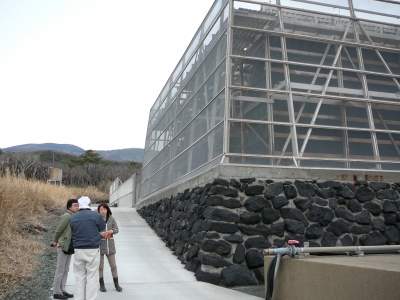 As it is located in a national park, it is designed to blend in with the landscape.The sea is right across the salt fields.Toshima, one of the seven islands of Izu, could be seen on the other side.
As it is located in a national park, it is designed to blend in with the landscape.The sea is right across the salt fields.Toshima, one of the seven islands of Izu, could be seen on the other side. 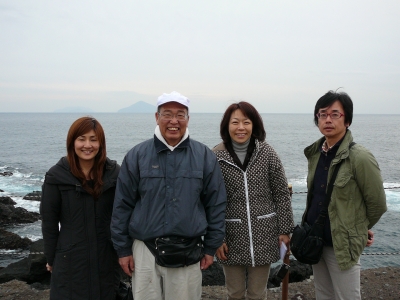 (From the left, Mr. Shimoda of the Sea Spirit, Mr. Terada, Mr. Shimada, and Mr. Nosaka) Move to the facility where "Hoshishio" is manufactured.
(From the left, Mr. Shimoda of the Sea Spirit, Mr. Terada, Mr. Shimada, and Mr. Nosaka) Move to the facility where "Hoshishio" is manufactured. 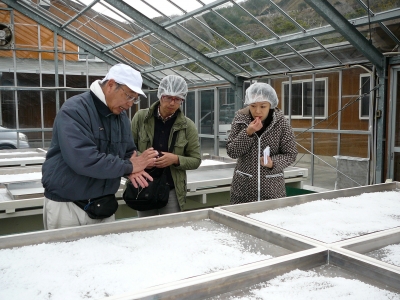 “Hoshishio” is domestic sun-dried salt.During the summer, concentrated seawater is dried in the sun in a greenhouse, the water is removed, and the finished product is dried in the winter.Because the salt crystals are large, it has a milder flavor than regular Arashio.In the evening, we had dinner at Hotel Akamon.
“Hoshishio” is domestic sun-dried salt.During the summer, concentrated seawater is dried in the sun in a greenhouse, the water is removed, and the finished product is dried in the winter.Because the salt crystals are large, it has a milder flavor than regular Arashio.In the evening, we had dinner at Hotel Akamon. 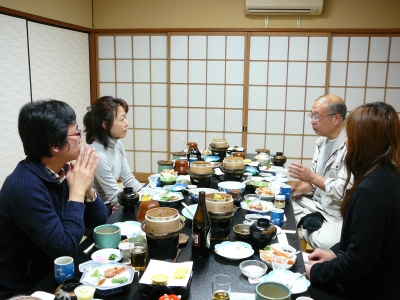 “Hotel Akamon” is a ryokan run by descendants of Minamoto no Tametomo, who used to live in the mansion when he was exiled to Oshima.There is also the grave of Tametomo, so some people come from Okinawa, where there is a legend that Tametomo was the founder of the Ryukyu Kingdom royal family.
“Hotel Akamon” is a ryokan run by descendants of Minamoto no Tametomo, who used to live in the mansion when he was exiled to Oshima.There is also the grave of Tametomo, so some people come from Okinawa, where there is a legend that Tametomo was the founder of the Ryukyu Kingdom royal family. 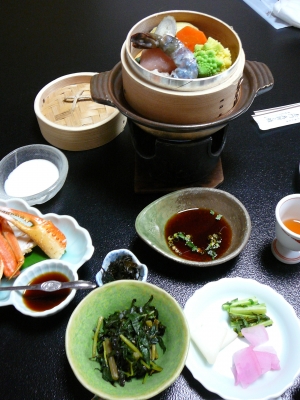
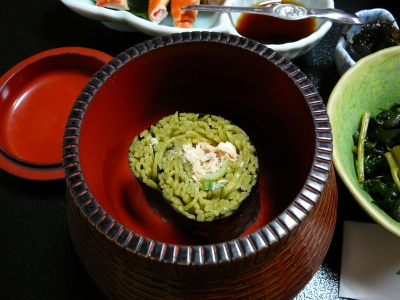
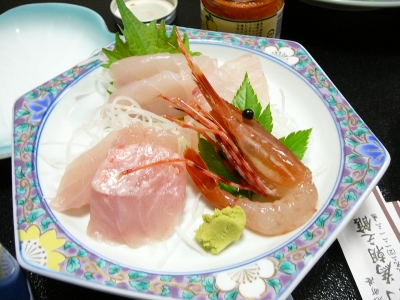
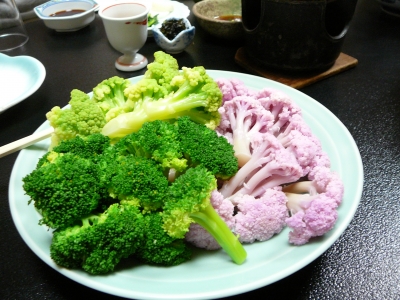
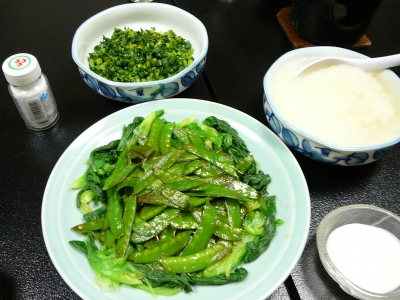
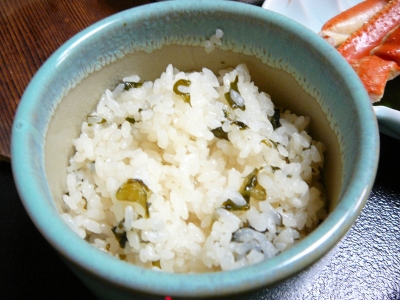 Island specialty Ashitaba and hamba seaweed small bowl (bottom of the first photo of the dish), Ashitaba soba sushi, local vegetables boiled and stir-fried, hanba seaweed rice, etc. Sea spirits such as “Yakishio” and “Yuzu gosho” were added to the feast of fruits of the sea, delicacies of the island, and vegetables, and flowers bloomed in the discussion of salt and macrobiotics.
Island specialty Ashitaba and hamba seaweed small bowl (bottom of the first photo of the dish), Ashitaba soba sushi, local vegetables boiled and stir-fried, hanba seaweed rice, etc. Sea spirits such as “Yakishio” and “Yuzu gosho” were added to the feast of fruits of the sea, delicacies of the island, and vegetables, and flowers bloomed in the discussion of salt and macrobiotics. The next day, we went to the “Motomachi factory” where “Arashio” and “Yakishio” are manufactured.
The next day, we went to the “Motomachi factory” where “Arashio” and “Yakishio” are manufactured. 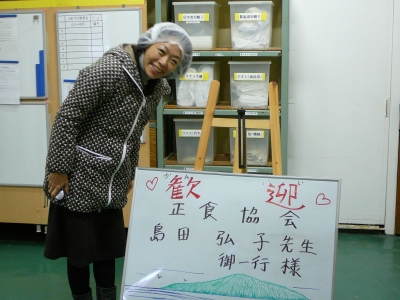 There was a welcome board at the entrance.
There was a welcome board at the entrance. Dust your jacket with a roller, put on shoe covers, wash your hands, and proceed to the factory.Inside, a number of large cauldrons were steaming.Concentrated seawater "kansui" is boiled in a "flat kettle" to make "arashio".
Dust your jacket with a roller, put on shoe covers, wash your hands, and proceed to the factory.Inside, a number of large cauldrons were steaming.Concentrated seawater "kansui" is boiled in a "flat kettle" to make "arashio". 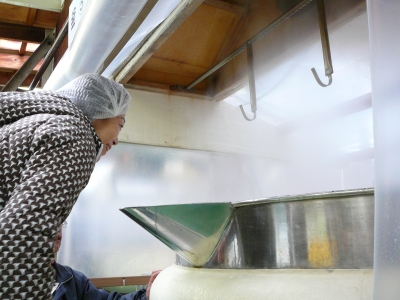 ↑A stepladder is put out so that we can look inside the kettle.Periodically boil down the seawater, cool it down and measure the concentration.
↑A stepladder is put out so that we can look inside the kettle.Periodically boil down the seawater, cool it down and measure the concentration. 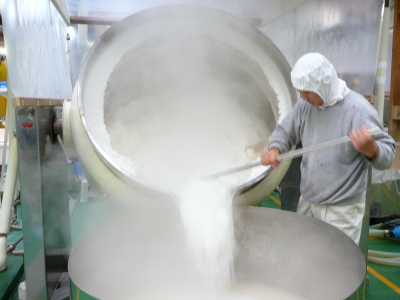 Leave the salt at the bottom of the pot.Since salt accumulates in layers, there is more calcium in the lower part, and it seems that the taste is different. (The product that makes use of this part is called “Toothpaste with Salt.”) Then, let it cool a little to stabilize the crystals.Then, it comes out divided into “arashio” and “bittern”.
Leave the salt at the bottom of the pot.Since salt accumulates in layers, there is more calcium in the lower part, and it seems that the taste is different. (The product that makes use of this part is called “Toothpaste with Salt.”) Then, let it cool a little to stabilize the crystals.Then, it comes out divided into “arashio” and “bittern”. 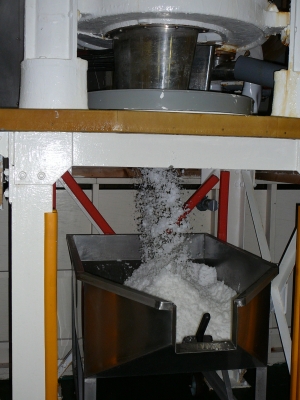 ↑This is the “Arashio” at the moment of completion.Then, "Yakishio" puts this completed "Arashio" in a jar, puts a lid on it, and puts it in a kiln that fires pottery.Bagging and bottling are actually hand-packed one by one. He said, ``Since there are many kinds of products, it is better to do it by hand because it is more efficient for him''. rice field.At noon, he had the school lunch that everyone was eating at the factory.Basically, vegetables are served, and fish is served only when fishermen give it to them, which is almost macrobiotic.Ashitaba, a special product, appears on the dining table almost every day as some kind of dish.
↑This is the “Arashio” at the moment of completion.Then, "Yakishio" puts this completed "Arashio" in a jar, puts a lid on it, and puts it in a kiln that fires pottery.Bagging and bottling are actually hand-packed one by one. He said, ``Since there are many kinds of products, it is better to do it by hand because it is more efficient for him''. rice field.At noon, he had the school lunch that everyone was eating at the factory.Basically, vegetables are served, and fish is served only when fishermen give it to them, which is almost macrobiotic.Ashitaba, a special product, appears on the dining table almost every day as some kind of dish. 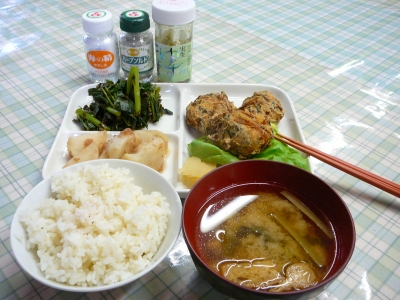 Here, too, we use “yakishio,” “herb salt,” and “yuzu gosho” from a manufacturer that uses sea salt as companions to the dining table.It's a little hard to tell, but the limited product "Sakura no Shio" is on top of the rice. (Cherry blossoms from the Yoshino region of Nara pickled in salt from the sea, and seasoned salt that he blended with salt.
Here, too, we use “yakishio,” “herb salt,” and “yuzu gosho” from a manufacturer that uses sea salt as companions to the dining table.It's a little hard to tell, but the limited product "Sakura no Shio" is on top of the rice. (Cherry blossoms from the Yoshino region of Nara pickled in salt from the sea, and seasoned salt that he blended with salt. ) Before leaving Oshima, Mr. Shimada had a camellia branch that was growing in the factory cut as a memorial.
) Before leaving Oshima, Mr. Shimada had a camellia branch that was growing in the factory cut as a memorial. 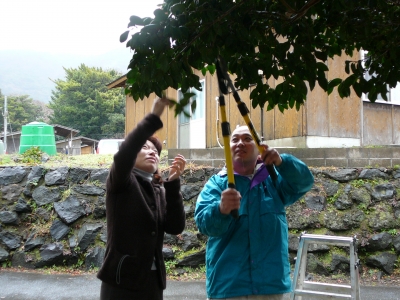 (Those who cut the trees are also the people at the factory. If you think they are familiar with it, they used to be a gardener!) There are so many camellias in bloom in the gardens of the houses, in the parks, and on the road from the factory to the port. was
(Those who cut the trees are also the people at the factory. If you think they are familiar with it, they used to be a gardener!) There are so many camellias in bloom in the gardens of the houses, in the parks, and on the road from the factory to the port. was 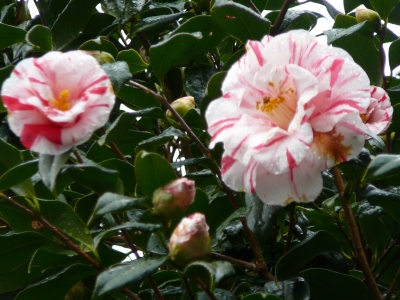 Double, red, white, various camellias are in full bloom.
Double, red, white, various camellias are in full bloom. 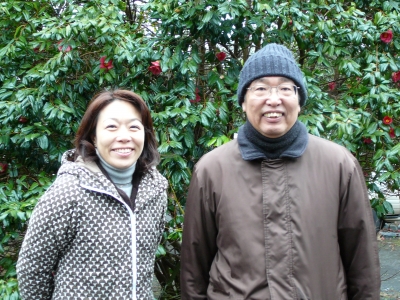 President Terada and Professor Shimada in front of camellias in the park.On the way back, the ferry departs from Okada Port.It was the day of the Solomon Islands earthquake, and I was worried about the tsunami.I would like to express my sincere gratitude to Mr. Terada and all the sea spirits for giving me such a valuable experience.It was a good opportunity to face salt again, and I was able to think about "Shindo Fuji" and "Ichibutsu whole".Now.It has been decided that the cooking class "Umisei Salon" hosted by Umisei, who makes such wonderful salt, will be held at Seishoku Cooking School Osaka Main Campus on Sunday, June 6rd.
President Terada and Professor Shimada in front of camellias in the park.On the way back, the ferry departs from Okada Port.It was the day of the Solomon Islands earthquake, and I was worried about the tsunami.I would like to express my sincere gratitude to Mr. Terada and all the sea spirits for giving me such a valuable experience.It was a good opportunity to face salt again, and I was able to think about "Shindo Fuji" and "Ichibutsu whole".Now.It has been decided that the cooking class "Umisei Salon" hosted by Umisei, who makes such wonderful salt, will be held at Seishoku Cooking School Osaka Main Campus on Sunday, June 6rd. Professor Hiroko Shimada.Details ↓ http://www.uminosei.com/uminoseiclub/salon.html For inquiries, please contact "Sea Spirit"
Professor Hiroko Shimada.Details ↓ http://www.uminosei.com/uminoseiclub/salon.html For inquiries, please contact "Sea Spirit"
+ + + + + + + + + + + + + + + + + + + + + + + + + + + + + + + + + + + + + + + +
macro pocket(Regular Diet Association Secretariat)
JAPAN MACROBIOTIC ASSOCIATION
https://www.macrobiotic.gr.jp/
+ + + + + + + + + + + + + + + + + + + + + + + + + + + + + + + + + + + + + + + +